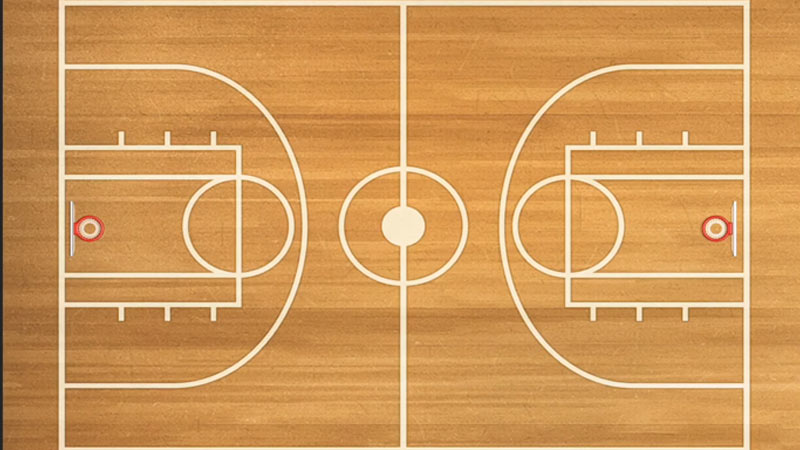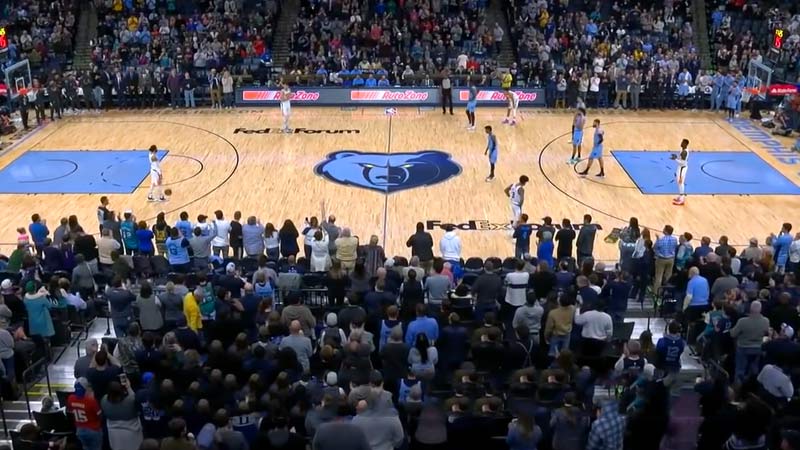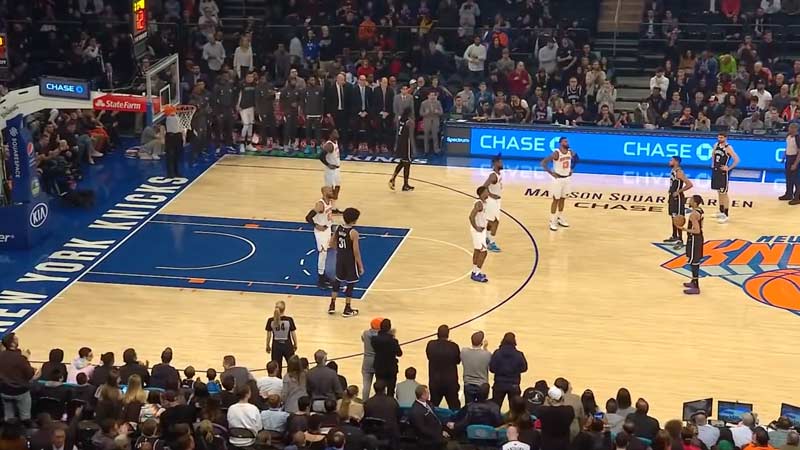Basketball is a dynamic and thrilling sport, and understanding its various elements is essential for players, coaches, and fans alike.
One crucial component of the basketball court is the end line, which serves as a boundary defining the length of the playing area.
In this article, we will delve into the concept of the end line in basketball, explore its dimensions, discuss the associated rules, and shed light on its significance within the game. So, stay focused.
What is the End Line in Basketball?
The end line in basketball is a boundary line located at each end of the court. It stretches horizontally from sideline to sideline, defining the length of the playing area. The standard dimension of the end line is 50 feet (15.24 meters) in length.
It plays a significant role in the game, influencing player positioning, offensive and defensive strategies, and various game situations.
The rules associated with the end line are crucial for players, coaches, and officials to ensure fair play and accurate decision-making on the court.
What Is the Dimension of the End Line in Basketball?
The end line, also commonly referred to as the baseline, serves as a significant boundary line at each end of the basketball court. It runs horizontally across the width of the court, stretching from one sideline to the other.
The standard dimension of the end line is 50 feet (15.24 meters) in length. This dimension ensures consistency and uniformity in basketball courts across various leagues and competitions.
The end line plays a crucial role in defining the limits of the court and establishing the area where various actions take place.
It serves as a reference point for determining out-of-bounds calls, such as when a player steps or lands on or beyond the end line.
Additionally, the end line influences offensive and defensive strategies, as teams must consider their positioning in relation to this boundary when executing plays or defending against their opponents.
While the standard dimension of the end line is 50 feet, it’s worth noting that slight variations may exist in different leagues or levels of play.
Some basketball courts may have minor adjustments to the length of the end line due to specific venue constraints or regional regulations.
However, regardless of any slight differences, the end line remains a fundamental element of the court, delineating the boundaries for gameplay and contributing to the overall structure of the game.
What is the End Line Rule in Basketball?

The end line rule in basketball is a fundamental aspect of the game that specifically addresses actions and situations occurring near or involving the end lines of the court.
It establishes guidelines and regulations to maintain fairness, control player movements, and facilitate accurate decision-making by officials. These rules are essential for players, coaches, and officials alike.
Out-of-Bounds Situations
One of the primary areas where the end line rule comes into play is in out-of-bounds situations. When the ball crosses the end line, either by being touched or possessed by a player who is out of bounds or by bouncing out of bounds, it is considered out-of-bounds.
The opposing team is then awarded possession of the ball for a throw-in from the sideline at the point of the violation. This rule ensures that the ball remains in play within the boundaries of the court.
Baseline Plays
The end line rule also governs various plays and actions that occur along the baseline of the court.
For example, when an offensive player drives towards the basket from the side of the court, they must be mindful of not stepping out of bounds before attempting a shot or making a pass.
If they do, it results in a turnover, and the opposing team gains possession of the ball. Additionally, the end line rule is relevant when determining whether a shot was taken before the shot clock or game clock expires.
Rebounding and Scoring
The end line rule plays a significant role in rebounding and scoring situations. When a player attempts a shot and the ball touches the end line, it is considered out-of-bounds and results in a turnover, regardless of whether the shot was successful or missed.
Moreover, if a player catches a rebound while standing out of bounds, it is deemed a violation, and the opposing team is awarded possession.
This rule ensures that players remain in the field of play during rebounding and scoring attempts.
Shot Clock Reset
The end line rule also influences the shot clock reset. In some situations, when the offensive team gains possession of the ball after a shot has hit the rim, the shot clock may reset to a specific time, often 14 or 24 seconds, depending on the league or competition rules.
This reset allows the offensive team a new opportunity to attempt a shot within the given time frame, ensuring a fair balance between offense and defense.
Significance of the End Line Rule in Basketball?

The end line rule, also known as the baseline or back line, is a fundamental aspect of basketball that holds significant importance in the sport.
It serves multiple purposes and has a direct impact on the gameplay, strategies, and various game situations. Let’s delve deeper into the significance of the end line rule in basketball.
Establishing Boundaries and Preventing Violations
One of the primary functions of the end line rule is to establish the boundaries within which players must operate.
The end line serves as a clear indicator of the court’s limits, preventing players from stepping out of bounds and committing violations.
By defining the boundaries, the end line rule ensures that the game is played within the designated area, maintaining fairness and preventing unfair advantages.
Influencing Offensive and Defensive Strategies
The end line rule plays a crucial role in shaping offensive and defensive strategies in basketball.
For the offensive team, the end line provides a reference point for creating scoring opportunities. Players often utilize the baseline to set up plays, execute drives to the basket, or create spacing for shooters.
On the defensive end, the end line is a key factor in positioning and guarding against baseline drives or preventing opponents from scoring near the basket.
Impact on Various Game Situations
The end line rule influences several game situations in basketball. During inbound plays, the offensive team must inbound the ball from out of bounds along the end line.
This rule adds complexity to the game, as teams strategize to create open passing lanes and scoring opportunities. Moreover, the end line comes into play when players attempt shots near the basket.
Offensive players often try to maneuver along the baseline for advantageous scoring positions, while defenders aim to protect the basket and contest shots effectively.
Additionally, the end line rule impacts decisions made by officials. They closely observe the positioning of players and their relation to the end line to determine whether shots are considered valid, whether players are in or out of bounds, and whether fouls or violations have occurred near the baseline.
The end line provides a clear reference point for officials to make accurate judgments during the game.
FAQs
What happens if a player steps on or crosses the end line?
Stepping on or crossing the end line results in the player being out of bounds. This leads to a turnover, with possession awarded to the opposing team.
Can a player score a basket while touching the end line?
Yes, a player can score a basket while touching the end line. As long as the player is inbounds and releases the ball before stepping out of bounds, the basket is considered valid.
What is an end line violation?
An end line violation occurs when a player commits a rule infraction involving the end line.
This can include stepping on or crossing the end line, failing to inbound the ball properly, or making illegal contact with an opponent near the end line.
Can a player save a ball from going out of bounds by throwing it off the end line?
No, a player cannot save a ball from going out of bounds by throwing it off the end line. If a player is the last one to touch the ball before it goes out of bounds, possession is awarded to the opposing team.
Are there any specific rules regarding inbound plays from the end line?
Yes, there are rules governing inbound plays from the end line. The player making the inbound pass must not step on or cross the end line while making the pass.
Additionally, defenders must give the inbounder sufficient space to inbound the ball without interference.
Bottom Line
The end line in basketball serves as a crucial boundary that defines the length of the playing area. Its dimensions, rules, and significance are essential for players, coaches, and officials.
By adhering to the end line rule, players can maintain proper positioning, execute strategic plays, and ensure fair play.
The end line plays a significant role in various game situations, from inbound plays to defensive strategies near the basket.
So, next time you watch a basketball game, keep an eye on that distinct boundary known as the end line and appreciate its impact on the game. Best of luck.







